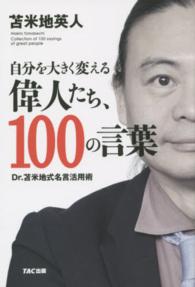- ホーム
- > 洋書
- > 英文書
- > History / World
Full Description
This introduction to the structure and context of archaeology in Britain reviews the vital issues facing archaeologists during a period in which the discipline has become increasingly complicated and diverse. The authors offer an analysis of the crucial questions of principle and practice that have arisen. In particular, they examine the implications for the archaeological profession of heritage management and legislation, stricter planning controls, changing land use, and the pressure of public interest and concern. Detailed consideration is given to the national database, the state of legislation on ancient monuments and portable antiquities, and archaeological aspects of planning policy and the preservation of standing buildings. An extensive section concentrates on the operation of professional archaeology and on the problems confronting archaeologists in the field. Individual chapters are devoted to the growth and management of archaeological units and trusts, to research design and consultancy, and to the presentation of archaeology to the public.
This wide-ranging coverage of the subject should make the title a useful handbook for field archaeologists, archaeology students and heritage managers in Britain. Planners concerned with archaeological remains and managers responsible for cultural and natural resources should also find the title a useful source of reference.
Contents
Part I Structure: archaeology in a matrix, Peter Fowler; changing configurations - the relationships between theory and practice, Ian Hodder; the British archaeological database, David Fraser; the structure of British archaeology, John Hunter, Ian Ralston, Ann Hamlin. Part II Frameworks: ancient monuments legislation, David J. Breeze; portable antiquities, Ian Longworth; the management of archaeology underwater, Anthony Firth; listed buildings, Roger W. Suddards; ecclesiastical buildings in use, Carl Bianco; local authority opportunities, David Baker, Ian Shepherd; British archaeology in a wider context, Henry Cleere; curation overview, Jane Grenville; appendix - frameworks legislation in Northern Ireland, Ann Hamlin. Part III Practice: English Heritage funding policies and their impact on research strategy, Roger Thomas; English archaeological units as contractors, Andrew J. Lawson; the archaeologist as consultant, Simon Collcutt; working practices, Timothy Darvill; assessment of field remains, Bill Startin; development of remote sensing, part 1 - aerial photography for archaeology, Robert H. Bewley; development of remote sensing, part 2 - practice and method in the application of geophysical techniques in archaeology, Chris Gaffney, John Gater; the dissemination of information, Catherine Hills; visitors welcome, Mike Parker Pearson; museum archaeology, Susan Pearce; archaeology as land use, Lesley Macinnes.






